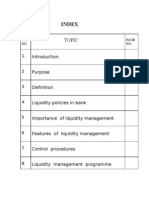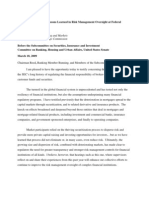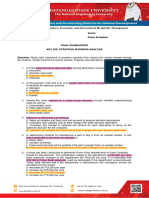Benefits
Benefits
Uploaded by
Sumit SinghCopyright:
Available Formats
Benefits
Benefits
Uploaded by
Sumit SinghOriginal Title
Copyright
Available Formats
Share this document
Did you find this document useful?
Is this content inappropriate?
Copyright:
Available Formats
Benefits
Benefits
Uploaded by
Sumit SinghCopyright:
Available Formats
n the banking system, high level of NPAs can be serious drag on overall performance of economy on account of diversion of its
management and financial resources towards recovery of NPAs. Greater the resources needed by banks to reserve for losses, lesser is the amount of capital they can leverage. Consequently it makes the banks risk averse in providing new loans leading to credit crunch in the financial market, amounting to economic and financial degradation. ARCs are established to acquire, manage, and recover illiquid or NPAs from lenders, unlocking value trapped in them via an institutional platform. Benefits
Relieving banks of the burden of NPAs would allow them to focus better on managing the core business including new business opportunities. The transfer should help restore depositor and investor confidence by ensuring the lenders financial health. ARCs are meant to maximise recovery value while minimizing costs. ARCs can also help build industry expertise in loan resolution, besides serving as a catalyst for important legal reforms in bankruptcy procedures and loan collection. ARCs can play an important role in developing capital markets through secondary asset instruments.
ARC Ownership Models Different countries have tried out varying models of ownership of ARCs. The options range from asset workout departments or units of banks, bank-owned subsidiaries or affiliated companies, private companies, and government owned asset management agencies. The severity or systemic nature of a countrys NPA problem usually dictates the NPA resolution strategy and the parameters for judging its success. A countrys institutional, legal, and market conditions also influence the decision. Typically, the primary goal is to maximise net present value recovery in order to minimise losses to either the selling bank or the government, depending on the ARC model used. Government-based ARCs may have additional challenges such as minimising adverse market impact from the asset recovery process or helping to rehabilitate troubled banks and distressed borrowers. In general, most bank resolution programs involve removing NPA from normal bank operations. ARCs usually operate through one of the two basic models namely bank based model, which is a decentralised approach or a government based model, centralised approach. Government Based ARCs In a government based model, an agency is sponsored by government which acquires and resolves the bad assets. The NPAs are owned by the government and managed by the ARC or partially contracted out to private managers. The ARC can be a special-purpose organisation which will be entrusted to acquire, manage and recover NPAs. It can also have other operations like deposit insurance or bank recapitalisation. Moreover in this model, centralisation of NPA provides effective asset packaging and marketing, ensuring consistency and transparency within the ARC. In addition, the risk of decrease in sale values of assets by the competing bank based ARCs is also reduced. Bank based ARCs A bank based model has two approaches viz workout units and bad banks. In workout units, NPAs are moved to a separate bank department but remain in the banks books. On the other hand, the bad bank approach includes the transfer of NPAs to a separate affiliated organisation i.e. ARC, which specialises in the management of bad assets. However, a government based model is more effective in an economy where the NPA problem is more pervasive and business environment or legal infrastructure is less developed. A bank based model is generally appropriate when the NPA problems are limited and concentrated. Valuing Distressed Asset Valuation techniques are needed in order to make informed decisions regarding asset purchase price as well as the timing and the nature of sales transactions and other sales strategies. The valuation process can also influence other decisions, such as whether or not to provide seller financing or to fund asset enhancements (or even the operations of a business). Valuation should play a major role in deciding whether or not to engage in debt-for-equity swaps with borrowers or in determining the funding cost of
providing equity participation. Additionally, asset valuation procedures are necessary in monitoring and reporting on the financial condition of the ARC. The first step in valuation is to collect the necessary information about the loan and then to stratify and segment the asset pool by size, industry, operating condition, and location. Sources of information include loan files, bank files, service providers, bankruptcy procedures, the trustee/ receiver, feasibility studies, appraisals, industry and sector details. The ARC specifies the minimum level of information desired for each category of loans, based on the availability of information and asset value. It should require selling banks to furnish asset information to guide betterthan -liquidation pricing. The type of information that is necessary for analysis may include rescheduled loan payment and workout plans, payment history, rank of obligation in priority of claims, property descriptions, and description and value of collateral. With this information, the ARC should determine a valuation methodology, based on asset categories and recovery strategies, and then develop an appropriate model to derive the investment value. The more significant an asset, the more rigorous the valuation effort should be. The AMC should develop due-diligence material, ideally in a standard format, taking the asset information into account. Resolution Strategy for NPA After acquiring the NPA from the sellers, the ARC will implement the resolution strategy for the underlying assets of the non performing loan. The ARC has been given powers by the SARFAESI Act to execute the resolution of NPA whereby it can:
Restructure the loan. Sell or lease part/whole of the assets or the business to a third party. Change the management structure by introducing its own personnel in the management. (presently this section has been kept in abeyance by the regulator) Restructure the business operations including diversification of business operations or discontinue the loss making business segment.
Disposition Strategies A number of sales techniques are possible. These include -
Portfolio sales Open outcry and sealed-bid auctions Securitisation Equity participation transactions
Transaction Structures Stage 1: Initially, an ARC acquires NPA by floating an SPV which acts as a trust whereby the ARC is a trustee and manager. NPA are acquired from banks/FIs at fair value based on assessment of realisable amount and time to resolution. The banks/FIs may receive cash/bonds/debentures as consideration or may invest in securities issued by the ARCs. The trust acquires NPAs from banks/FIs and raises resources by formulating schemes for the financial assets taken over. Accordingly, it issues securities to the investors which are usually QIBs. Securities represent undivided right, title and interest in the trust fund. Subsequently, the ARC redeems the investment to the bank/FIs out of the funds received from the issued securities. After acquiring the NPA, the trust becomes the legal owner and the security holders its immediate beneficiaries. The NPAs acquired are held in an asset specific or portfolio trust scheme. In the portfolio approach, due to the small size of the aggregate debt the ARC makes a portfolio of the loan assets from different banks and FIs. Whereas when the size of the aggregate debt of a bank/FI is large, the trust takes asset specific approach.
Stage 2: Thereafter, different fund schemes are pooled together in a master trust scheme and sold to other investors. The ARC periodically declares the NAV of respective schemes.
You might also like
- Business A Changing World 5th Ed. CANADADocument484 pagesBusiness A Changing World 5th Ed. CANADAAditya Pratap Singh100% (1)
- Financial Statement Anlysis 10e Subramanyam Wild Chapter 4 PDFDocument43 pagesFinancial Statement Anlysis 10e Subramanyam Wild Chapter 4 PDFRyan75% (4)
- Real Estate Securitization Exam NotesDocument33 pagesReal Estate Securitization Exam NotesHeng Kai Li100% (1)
- Macroeconomics - Principles and PoliciesDocument6 pagesMacroeconomics - Principles and PoliciesJasneet BaidNo ratings yet
- Catching Up, Forging Ahead, and Falling Behind (Abramovitz)Document3 pagesCatching Up, Forging Ahead, and Falling Behind (Abramovitz)AB-0% (1)
- A New World of Golden and SilverDocument365 pagesA New World of Golden and SilverEsther MartinezNo ratings yet
- Rosetta StoneDocument3 pagesRosetta Stonedxc126700% (1)
- Inside Job TermsDocument8 pagesInside Job TermsKavita SinghNo ratings yet
- Banking - Unit - Assets and Liability ManagmentDocument54 pagesBanking - Unit - Assets and Liability ManagmentDarshini Thummar-ppmNo ratings yet
- Credit AppraisalDocument6 pagesCredit AppraisalAnjali Angel ThakurNo ratings yet
- Claims and Recoveries: Fide Claims Against The Bank. This Paper Considers The Major ObjectivesDocument11 pagesClaims and Recoveries: Fide Claims Against The Bank. This Paper Considers The Major Objectivesdsmile1No ratings yet
- Chapter 5 - Working Capital ManagementDocument10 pagesChapter 5 - Working Capital ManagementRoshel ChilaganNo ratings yet
- Leveraged BuyoutsDocument12 pagesLeveraged BuyoutsLeonardo100% (1)
- Ailing Banks Where Is AMCDocument3 pagesAiling Banks Where Is AMCMohammad Shahjahan SiddiquiNo ratings yet
- 5 6239879704837362436Document16 pages5 6239879704837362436seamhasankhan04No ratings yet
- Managemnt of Capital in BanksDocument8 pagesManagemnt of Capital in Banksnrawat12345No ratings yet
- Explain The Scope, Importance, Features, Advantages and Disadvantages of Securitization (Special Purpose Vehicle)Document6 pagesExplain The Scope, Importance, Features, Advantages and Disadvantages of Securitization (Special Purpose Vehicle)somilNo ratings yet
- Financial Statement Anlysis 10e Subramanyam Wild Chapter 4Document43 pagesFinancial Statement Anlysis 10e Subramanyam Wild Chapter 4Muhammad HamzaNo ratings yet
- Liquidity ManagementDocument60 pagesLiquidity ManagementRomil Parikh100% (1)
- NPA Management: - Role of Asset Reconstruction CompaniesDocument6 pagesNPA Management: - Role of Asset Reconstruction CompaniestapanrNo ratings yet
- CH 10Document20 pagesCH 10NGỌC ĐẶNG HỒNGNo ratings yet
- Dealing With NonDocument5 pagesDealing With NonDharmendra KumarNo ratings yet
- Credit Card Securitization ManualDocument18 pagesCredit Card Securitization ManualRahmi Elsa DianaNo ratings yet
- Collection Recovery PolicyDocument19 pagesCollection Recovery Policygopal03july90No ratings yet
- AIFsDocument10 pagesAIFs20ba092No ratings yet
- Amar Gupta MFI - Chapter 2 - 1Document72 pagesAmar Gupta MFI - Chapter 2 - 1Bharath SNo ratings yet
- Q1) Rating Methodology Adopted by Credit Rating Anency/ Icra Rating Scale of Corporate GovernanceDocument20 pagesQ1) Rating Methodology Adopted by Credit Rating Anency/ Icra Rating Scale of Corporate GovernanceNikhilNo ratings yet
- Chapter - 9 Investment Portfolio and Liquidity ManagementDocument16 pagesChapter - 9 Investment Portfolio and Liquidity Managementsahil ShresthaNo ratings yet
- Role of Merchant Banking - : Raising FinanceDocument10 pagesRole of Merchant Banking - : Raising FinanceAadil KakarNo ratings yet
- Trial Exam Spring 2017Document3 pagesTrial Exam Spring 2017Mega Pop LockerNo ratings yet
- A Study On Credit Appraisal For Working Capital Finance To Smes at Ing Vysya BankDocument22 pagesA Study On Credit Appraisal For Working Capital Finance To Smes at Ing Vysya Bankprincejac4u2478894No ratings yet
- Chapter 2 Tutorial AnswersDocument5 pagesChapter 2 Tutorial AnswersHeri LimNo ratings yet
- Bank RegulationDocument6 pagesBank RegulationAndre WestNo ratings yet
- Director, Division of Trading and Markets U.S. Securities and Exchange CommissionDocument12 pagesDirector, Division of Trading and Markets U.S. Securities and Exchange CommissionrlindseyNo ratings yet
- Non-Performing Assets Asset and Liability Management by The: BanksDocument15 pagesNon-Performing Assets Asset and Liability Management by The: BanksCeline StuartNo ratings yet
- ARC - Role of Asset Reconstruction Companies in India in Reduction of NPAsDocument6 pagesARC - Role of Asset Reconstruction Companies in India in Reduction of NPAsGreeshma ChittilappillyNo ratings yet
- Reforms in Banking SectorDocument3 pagesReforms in Banking SectorVyoma ReenuNo ratings yet
- Liquidity ManagementDocument51 pagesLiquidity Managementnikhil198924100% (2)
- Credit ManagementDocument29 pagesCredit ManagementShane DiestroNo ratings yet
- Chapter II Policies and Structure For Credit ManagementDocument4 pagesChapter II Policies and Structure For Credit ManagementPradeep GautamNo ratings yet
- Treasury FunctionsDocument2 pagesTreasury Functionssunshine9016No ratings yet
- Afm Ia & BFDocument6 pagesAfm Ia & BFSumit Raj WadhwaniNo ratings yet
- Synopsis ON "Role and Need of Merchant Bankers in Ipo: M.Rajashekar (REG NO. 11SLCMA104)Document7 pagesSynopsis ON "Role and Need of Merchant Bankers in Ipo: M.Rajashekar (REG NO. 11SLCMA104)shiva7363No ratings yet
- ALM ProjectDocument85 pagesALM ProjectSrikanth BheemsettiNo ratings yet
- ASSET LIABILITIES Mnagament in BanksDocument25 pagesASSET LIABILITIES Mnagament in Bankspriyank shah100% (6)
- Affairs Mind May 2024 Best 200 MCQsDocument601 pagesAffairs Mind May 2024 Best 200 MCQsvarda.ghare09No ratings yet
- Frequently Asked Questions (FAQ) For Implementing March 2013 Interagency Guidance On Leveraged LendingDocument8 pagesFrequently Asked Questions (FAQ) For Implementing March 2013 Interagency Guidance On Leveraged Lendinged_nycNo ratings yet
- Securitization of DebtDocument52 pagesSecuritization of Debtnjsnghl100% (2)
- Liquidity & Reserve ManagementDocument32 pagesLiquidity & Reserve Managementmitchelle.hularNo ratings yet
- Assignment - Retail BankingDocument6 pagesAssignment - Retail BankingShivam GoelNo ratings yet
- Celent Buy Side Risk Impact NoteDocument20 pagesCelent Buy Side Risk Impact Noteimnowhere62No ratings yet
- Duke Fed Speech 9.14.09Document7 pagesDuke Fed Speech 9.14.09mrericwangNo ratings yet
- Chapter 2Document8 pagesChapter 2Pradeep RajNo ratings yet
- Credit Appraisal TechniquesDocument9 pagesCredit Appraisal TechniquesMragank Dixit0% (2)
- Bank Credit ManagementDocument18 pagesBank Credit Managementkenziemohamed810No ratings yet
- Va Sudha ProjectDocument28 pagesVa Sudha ProjectPranjal SrivastavaNo ratings yet
- Back To Basics: Non-Determinant DepositsDocument4 pagesBack To Basics: Non-Determinant DepositskalamayaNo ratings yet
- Liquidity Risk ManagementDocument3 pagesLiquidity Risk Managementsawantrohan214No ratings yet
- Agencies of Cash Flow: How to Raise and Invest Long-Term Money for Foundations and EndowmentsFrom EverandAgencies of Cash Flow: How to Raise and Invest Long-Term Money for Foundations and EndowmentsNo ratings yet
- Unlocking Capital: A Business Owner's Handbook to Small Business FinancingFrom EverandUnlocking Capital: A Business Owner's Handbook to Small Business FinancingNo ratings yet
- The Finace Master: What you Need to Know to Achieve Lasting Financial FreedomFrom EverandThe Finace Master: What you Need to Know to Achieve Lasting Financial FreedomNo ratings yet
- Advanced Corporate Finance: Assessment, Strategy and Risk: Modern Economics: Book Series for Beginners and ProfessionalsFrom EverandAdvanced Corporate Finance: Assessment, Strategy and Risk: Modern Economics: Book Series for Beginners and ProfessionalsNo ratings yet
- Expert Financial Analysis: Strategies for Professional SuccessFrom EverandExpert Financial Analysis: Strategies for Professional SuccessNo ratings yet
- Investment Valuation: Learn Proven Methods For Determining Asset Value And Taking The Right Investing DecisionsFrom EverandInvestment Valuation: Learn Proven Methods For Determining Asset Value And Taking The Right Investing DecisionsNo ratings yet
- New Microsoft Office Power Point PresentationDocument4 pagesNew Microsoft Office Power Point PresentationSumit SinghNo ratings yet
- Term Paper ON Event Management: Topic:"Ka-Boom" - A Hockey MatchDocument17 pagesTerm Paper ON Event Management: Topic:"Ka-Boom" - A Hockey MatchSumit SinghNo ratings yet
- Term Paper of Banking & Insurance: Topic: Micro Finance Development Overview and ChallengesDocument18 pagesTerm Paper of Banking & Insurance: Topic: Micro Finance Development Overview and ChallengesSumit SinghNo ratings yet
- MachinesDocument2 pagesMachinesSumit SinghNo ratings yet
- BALANCE OF PAYMENTS-PPT-AugustDocument18 pagesBALANCE OF PAYMENTS-PPT-AugustpravinNo ratings yet
- Basic Microeconomics (BA-C 211)Document58 pagesBasic Microeconomics (BA-C 211)Rezel FuntilarNo ratings yet
- MBA Strategies in Operations Management (Case Study)Document8 pagesMBA Strategies in Operations Management (Case Study)breetumyNo ratings yet
- FIN 439 Fall 17Document4 pagesFIN 439 Fall 17samenNo ratings yet
- Chapter 2 National IncomeDocument29 pagesChapter 2 National Incomeliyayudi0% (1)
- Lesson 5 and 6 - Elasticity of Supply and DemandDocument18 pagesLesson 5 and 6 - Elasticity of Supply and DemandCharles Corporal ReyesNo ratings yet
- Global Economic Prospects - SubSaharan Africa AnalysisDocument20 pagesGlobal Economic Prospects - SubSaharan Africa Analysisbello imamNo ratings yet
- A Flopro PLC Make and Sell Two Products A andDocument2 pagesA Flopro PLC Make and Sell Two Products A andAmit PandeyNo ratings yet
- Module 2 Time Value of MoneyDocument7 pagesModule 2 Time Value of MoneyZaid Ismail ShahNo ratings yet
- Interaction of Supply and DemandDocument19 pagesInteraction of Supply and DemandSarah Jane Greso100% (1)
- M.A Economics Syllabus University of PeshawarDocument30 pagesM.A Economics Syllabus University of PeshawarAsif Nawaz100% (1)
- Fy BFMDocument7 pagesFy BFMsatyam24kdemonNo ratings yet
- ACC 308 Multiple Choice QuestionsDocument18 pagesACC 308 Multiple Choice QuestionsAceain SoNo ratings yet
- MATP Session-8Document63 pagesMATP Session-8samal.arabinda25No ratings yet
- Lesson 1 - Introduction To Applied EconomicsDocument9 pagesLesson 1 - Introduction To Applied EconomicsLaila RodaviaNo ratings yet
- EconDocument12 pagesEconfranz justin kyle syNo ratings yet
- Internal AssessmentDocument3 pagesInternal AssessmentextravaganzaramjasNo ratings yet
- NoneDocument1 pageNonebaliNo ratings yet
- DKI's Economy: Navigating The Danger Zone: Fithra Faisal Hastiadi PH.D Executive Director of Next PolicyDocument46 pagesDKI's Economy: Navigating The Danger Zone: Fithra Faisal Hastiadi PH.D Executive Director of Next PolicyVesper 007No ratings yet
- Chapter 4 InvestmentDocument3 pagesChapter 4 InvestmentSeptian Pajrin MuktiNo ratings yet
- Equity Stock Market - Concepts, Instruments, Risks and Derivatives SyllabusDocument3 pagesEquity Stock Market - Concepts, Instruments, Risks and Derivatives SyllabusDeepankar KohliNo ratings yet
- Chapter 7 - International Parity Conditions - BlackboardDocument33 pagesChapter 7 - International Parity Conditions - BlackboardCarlosNo ratings yet
- Ancillary Unit, Tiny Unit & Role of EntrepreneurshipDocument14 pagesAncillary Unit, Tiny Unit & Role of EntrepreneurshipDinesh KcNo ratings yet
- ReillyBrown IAPM 11e PPT Ch01Document53 pagesReillyBrown IAPM 11e PPT Ch01rocky wong100% (1)





























































































